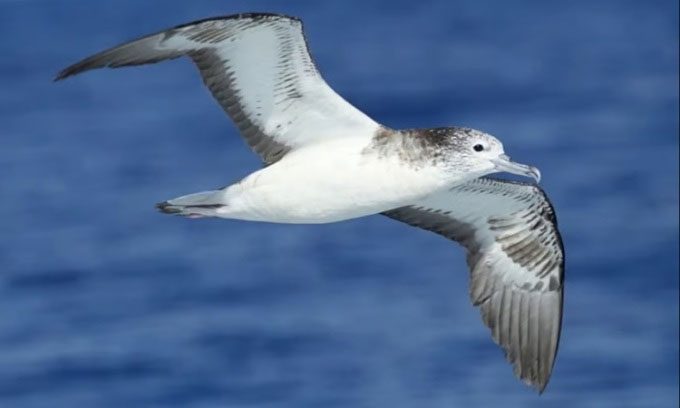A brave male white-faced albatross flew 1,146 kilometers in 11 consecutive hours to escape a typhoon with winds of 215 km/h that struck Japan in 2019.
The albatross flew above Typhoon Faxai as it made landfall in southeastern Japan. This marked the beginning of a 1,146 km journey lasting 11 hours, during which the bird soared to heights of over 4,572 meters, traveling at speeds three times faster than usual. Fortunately, it survived and returned to its kin. The findings of the albatross’s flight were published in the journal Ecology, with a report by New Atlas on October 26.

The white-faced albatross typically flies at a maximum height of 100 meters. (Photo: Wikipedia)
Utilizing GPS data loggers attached to 14 adult white-faced albatrosses (Calonectris leucomelas) in August of the same year by biologist Kozue Shiomi from Tohoku University to monitor nesting behavior, scientists were able to track this remarkable act of natural defiance and discovered an anomalous flight pattern coinciding with the storm. The male albatross was swept into the storm, although the research team could not determine whether it had intentionally flown into it or simply found itself in the wrong place at the wrong time. However, it was clear that the 585-gram bird had no choice but to fly with the storm.
Throughout the 11-hour flight, the bird completed five circular flight loops with diameters ranging from 50 to 80 km, riding the vortex and movement of the storm. While albatrosses typically fly below 100 meters, this bird ventured into entirely new territory, soaring up to 4,700 meters. By comparison, a small airplane usually flies at altitudes of 600 to 3,000 meters. The male albatross traveled at speeds between 90 and 170 km/h. The common cruising speed for white-faced albatrosses is 10 to 60 km/h.
The bird flew over the mainland of Japan before returning over the Pacific Ocean as the storm moved out to sea. At this point, the storm’s strength weakened, allowing the bird to restore its normal flight path and return to its flock near its nesting island.
The GPS timeline indicated that the bird spent some time in the eye of the storm but later flew a wider detour outside. It also exhibited an unusually late departure time for foraging compared to its species. “Taking off late in the afternoon from the breeding area is quite unusual for white-faced albatrosses, which typically forage a few hours before sunset. This may indicate that the bird was trying to avoid extreme conditions but was unsuccessful,” the research team noted.
Ocean-dwelling birds like the white-faced albatross spend the majority of their lives on the sea, coming ashore only to breed. They have diverse mechanisms and behaviors to avoid storms, from staying in the eye of the storm to flying at high altitudes above turbulence. However, increasingly frequent severe storms make it difficult for many bird species to cope. Shiomi emphasized that studying how seabirds respond to extreme weather events is crucial to understand how they react to rapid changes.




















































